
A tachograph is a device fitted to a vehicle that automatically records its speed and distance, together with the driver's activity selected from a choice of modes. The drive mode is activated automatically when the vehicle is in motion, and modern tachograph heads usually default to the other work mode upon coming to rest. The rest and availability modes can be manually selected by the driver whilst stationary.
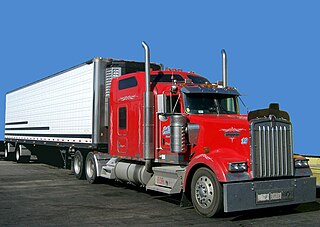
A commercial driver's license (CDL) is a driver's license required in the United States to operate large and heavy vehicles or a vehicle of any size that transports hazardous materials or more than 15 passengers.

A logbook is a record used to record states, events, or conditions applicable to complex machines or the personnel who operate them. Logbooks are commonly associated with the operation of aircraft, nuclear plants, particle accelerators, and ships.

A truck driver is a person who earns a living as the driver of a truck, which is commonly defined as a large goods vehicle (LGV) or heavy goods vehicle (HGV).
An event data recorder (EDR), more specifically motor vehicle event data recorder (MVEDR), similar to an accident data recorder, (ADR) sometimes referred to informally as an automotive black box, is a device installed in some automobiles to record information related to traffic collisions. In the USA EDRs must meet federal standards, as described within the U.S. Code of Federal Regulations.
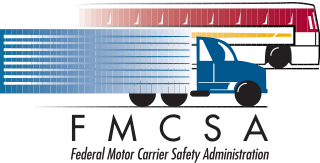
The Federal Motor Carrier Safety Administration (FMCSA) is an agency in the United States Department of Transportation that regulates the trucking industry in the United States. The primary mission of the FMCSA is to reduce crashes, injuries, and fatalities involving large trucks and buses.
Drivers' working hours is the commonly used term for regulations that govern the activities of the drivers of commercial goods vehicles and passenger carrying vehicles. In the United States, they are known as hours of service.
PrePass is an intelligent transportation system (ITS) that electronically verifies the safety, credentials, and weight of commercial vehicles as they approach participating state highway weigh stations. Because they comply electronically, commercial carriers enrolled in PrePass are authorized to bypass these facilities rather than pull in for manual inspection.

Hours of service (HOS) regulations are issued by the Federal Motor Carrier Safety Administration (FMCSA) and govern the working hours of anyone operating a commercial motor vehicle (CMV) in the United States. These regulations apply to truck drivers, commercial and intercity bus drivers, and school bus drivers who operate CMVs. These rules limit the number of daily and weekly hours spent driving and working, and regulate the minimum amount of time drivers must spend resting between driving shifts. For intrastate commerce, the respective state's regulations apply.

The Federal Bridge Gross Weight Formula, also known as Bridge Formula B or the Federal Bridge Formula, is a mathematical formula in use in the United States by truck drivers and Department of Transportation (DOT) officials to determine the appropriate maximum gross weight for a commercial motor vehicle (CMV) based on axle number and spacing. The formula is part of federal weight and size regulations regarding interstate commercial traffic. The formula is necessary to prevent heavy vehicles from damaging roads and bridges. CMVs are most often tractor-trailers or buses, but the formula is of most interest to truck drivers due to the heavy loads their vehicles often carry.
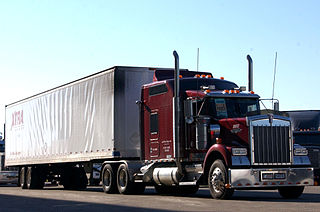
The trucking industry serves the American economy by transporting large quantities of raw materials, works in process, and finished goods over land—typically from manufacturing plants to retail distribution centers. Trucks are also used in the construction industry, two of which require dump trucks and portable concrete mixers to move the large amounts of rocks, dirt, concrete, and other building materials used in construction. Trucks in America are responsible for the majority of freight movement over land and are tools in the manufacturing, transportation, and warehousing industries.
The motor carrier safety rating is an evaluation given to an interstate commercial motor carrier by the Federal Motor Carrier Safety Administration (FMCSA).
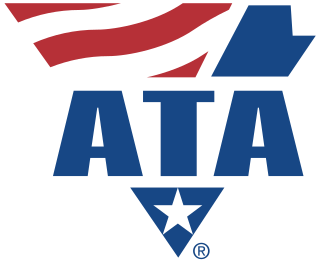
The American Trucking Associations (ATA), founded in 1933, is the largest national trade association for the trucking industry. ATA represents more than 37,000 members covering every type of motor carrier in the United States through a federation of other trucking groups, industry-related conferences, and its 50 affiliated state trucking associations. Former Governor of Kansas Bill Graves was replaced by Chris Spear as the ATA's president and CEO in July 2016.
XRS Corporation provided on-demand software and services to the trucking industry. Based in Eden Prairie, Minn., XRS's software solutions and services delivered data on vehicle and driver performance. Fleet managers, dispatchers and drivers collect, sort, view and analyze the data to improve savings, safety and regulatory compliance. Xata was the first company to introduce electronic driver logs and exception-based management reporting. Its fleet operations management systems have been installed on more than 100,000 commercial trucks at more than 2,000 customer locations. Its products helped fleet managers and drivers meet established and emerging electronic on-board recorder (EOBR) regulations from the Federal Motor Carrier Safety Administration. It was acquired by Omnitracs on November 2, 2014.
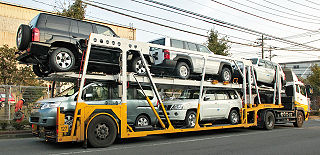
An auto transport broker is a type of cargo broker that specializes in the shipping and transportation of vehicles. Most vehicles shipped in the U.S. are cars and trucks, but many brokers handle boats, RVs, motorcycles and other types of vehicles as well. Auto transport is classified as "specialized freight trucking" under NAICS code 484230.

People who are driving as part of their work duties are an important road user category. First, workers themselves are at risk of road traffic injury. Contributing factors include fatigue and long work hours, delivery pressures, distractions from mobile phones and other devices, lack of training to operate the assigned vehicle, vehicle defects, use of prescription and non-prescription medications, medical conditions, and poor journey planning. Death, disability, or injury of a family wage earner due to road traffic injury, in addition to causing emotional pain and suffering, creates economic hardship for the injured worker and family members that may persist well beyond the event itself.
Drivewyze is an intelligent transportation system (ITS) service that provides bypasses to commercial vehicles as they approach participating state highway weigh stations. The participating vehicles' safety record, credentials and weight are verified automatically, and if they comply with that state's screening rules for automated bypass, the vehicles are authorized to bypass these facilities rather than pull in for manual inspection. This results in time and fuel savings for the truck and less vehicle congestion at the weigh station.

The accident data recorder is an independent electronic device that records before, during, and after a traffic accident relevant data and thus resembles a flight recorder.
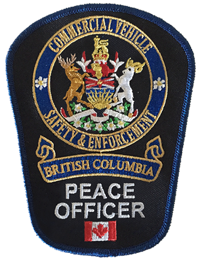
British Columbia Commercial Vehicle Safety & Enforcement is a provincial law enforcement agency that is responsible for the compliance and enforcement of the commercial transport sector, protection of the environment and transportation infrastructure of British Columbia, increasing road safety and protecting the motoring public.
An electronic logging device is a piece of electronic hardware attached to a commercial motor vehicle engine to record driving hours. The driving hours of commercial drivers are typically regulated by a set of rules known as the hours of service (HOS) in the United States and as drivers' working hours in Europe. The Commercial Vehicle Driver Hours of Service Regulations vary in Canada and the United States.















